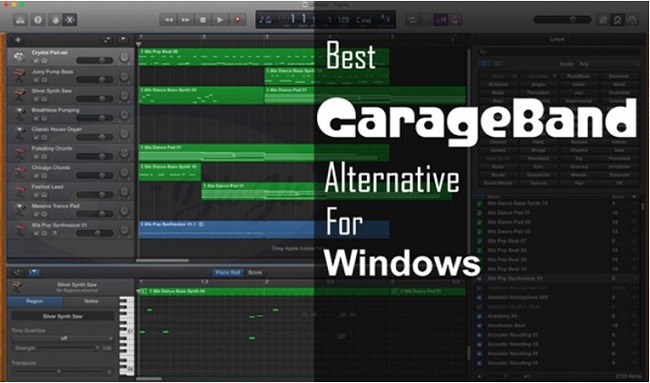When discussing open-source DAWs, or “Digital Audio Workstations,” GarageBand is often mentioned as a top contender. The fact that it’s free is undoubtedly a huge draw.
However, the availability of editing tools, native plugins, instruments and samples, and a plethora of additional “semi-professional” processing tools like compressors and EQs are the main reasons for GarageBand’s widespread success.
What are Some Best GarageBand Alternatives for PC

The free version of GarageBand is one of the best digital audio workstations (DAWs) out there. But there’s a catch: it’s exclusive to Apple devices. This post will examine 10 excellent substitutes for GarageBand for Windows and provide instructions for obtaining GarageBand for Windows.
A lot of people use GarageBand since it’s a well-known digital audio workstation (DAW), but I’m here to tell you that there are other options that are actually better for Windows.
If you’re just getting started with music production, the breakdown of free and paid resources that follows should be invaluable. These are some garageband alternative for windows.
Read Also:
1. Cakewalk by Bandlab
Roland’s $600 ‘Sonar’ digital audio workstation (DAW) was partially the inspiration for Cakewalk. Cakewalk by BandLab is the result of BandLab’s acquisition and expansion of the original Cakewalk platform.
Cakewalk’s full suite of plugins includes compressors, reverbs, EQs, and other mastering tools including limiters and multiband compressors, making it one of the most feature-rich free DAWs available for music production.
Cakewalk is compatible with nearly every third-party instrument and effect plugin (excluding RTAS and AAX formats) and is developed with the well-known ‘Skylight’ interface, providing an efficient and clean GUI and a lauded user experience.
BandLab supports infinite audio tracks, FX sends, and MIDI tracks, and users can use whatever VST plugins they like. It also has the closest features and aesthetics to Garageband of any digital audio workstation.
Cakewalk’s Lite version includes all of these essential functions without a free trial, upgrade, or subscription; in contrast, most industry software hides them behind a “paywall.”
Users may anticipate hardware support and integration on par with Apple’s patented Core Audio driver, thanks to the 64-bit mix engine, Windows 10 support, and ARA (Audio Random Access) features.
2. Akai MPC Beats
Multi-track recording, Audio Unit (AU) and Virtual Instrument (VST) support are just a few of the capabilities and functions available in MPC Beats. That are also found in the world’s main competitors’ full-priced DAWs (enabling the use of purchased third party plugins, effects and instruments).
MPC Beats can be downloaded and used as a plugin within other digital audio workstations (DAWs), allowing users to effectively run another DAW within their existing DAW. This is especially useful for those who already use a DAW and have a paid license for it (such as Logic, Live, FL Studio, or Reason).
Brilliantly, MPC Beats offers all the typical features of applications like Maschine (with a focus on generating beats and grooves) for zero dollars. Furthermore, MPC Beats has over 80 ‘native’ plugins, like as compressors, echo/delay/reverb, EQ, software synthesizers,
and more, in addition to its astounding 2GB of samples and sounds. If you have a beat pad, keyboard, or other digital instrument that is also class-compliant, you should be able to use it with MPC Beats without any problems.
3. CubaBase
Cubase has seen a meteoric rise in popularity among music producers and composers. It has quickly risen to become one of the most sought-after alternatives out there. Because it can do so much more, this can replace GarageBand in your studio. When it comes to the straightforwardness of the MIDI interface, Cubase’s origins run deep.
Quantizing and seeing MIDI while editing is a breeze. The significance of this is best explained by considering why it is so. To put it simply, it will make modifying MIDI a breeze. The interface is simple and easy to use, resulting in a brisk process once you’ve gotten the hang of it.
4. Ableton Live
Those who hope to one day perform live might consider switching to Ableton Live rather than GarageBand. It shares a lot of GarageBand’s features and even some of that program’s user interface design.
In addition to providing you with everything you might desire from a digital audio workstation, Ableton Live also comes with an infinite supply of tutorial videos available on YouTube. Many fantastic songs, such as those by twenty one pilots, have been created using Ableton Live’s in-built instruments.
Many of the synths on the album “Vessel” were sourced directly from Ableton Live’s library of free instruments. Aside from its basic looping and live-playing prowess, this alone makes Ableton Live a compelling option.
I cannot stress enough how useful YouTube will be as a learning tool for any of the alternatives discussed in this article. You may get answers to any queries you have and pick up a ton of useful tips and techniques in the process.
Details About the Garageband Website:
What is GarageBand?
GarageBand is a fully equipped music creation studio right inside your Mac — with a complete sound library that includes instruments, presets for guitar and voice, and an incredible selection of session drummers and percussionists.
It’s incredibly user-friendly, making it a favorite among beginners, yet robust enough for more experienced musicians.
Key Features of GarageBand
- Intuitive Interface: GarageBand boasts a user-friendly interface, making it easy for beginners to navigate.
- Extensive Sound Library: A vast array of instruments, loops, and sounds are available, suitable for various music genres.
- Virtual Instruments: Users can play a variety of instruments using their keyboard or MIDI controller.
- Recording and Editing Tools: GarageBand offers comprehensive recording and editing capabilities, allowing users to craft professional-quality music.
- Integration with Apple Ecosystem: Seamless integration with other Apple products and services enhances the user experience.
How GarageBand Works
GarageBand turns your device into a collection of Touch Instruments and a full-featured recording studio — so you can make music anywhere you go. It allows users to create music or podcasts using a variety of virtual instruments, audio loops, and recording tools. The software also supports external instruments and microphones for live recording.
The Accessibility of GarageBand
One of GarageBand’s most significant advantages is its accessibility:
- Free with Apple Devices: GarageBand is available for free with all new Macs, iPads, and iPhones.
- Ease of Use: Its intuitive design makes it easy for beginners to start creating music immediately.
- Education and Learning: The platform is widely used in educational settings, helping students learn music production basics.
Advanced Features for Professional Use
Despite its simplicity, GarageBand also caters to more advanced users:
- Multi-Track Recording: It supports multi-track recording, a must-have for complex music projects.
- Audio Effects: A range of audio effects can enhance the sound quality of recordings.
- Integration with Logic Pro X: For those who outgrow GarageBand, projects can be exported to Apple’s professional DAW, Logic Pro X, for further refinement.
The Impact of GarageBand on Music Production
GarageBand has significantly impacted the music production industry by:
- Democratizing Music Creation: It has made music production accessible to a broader audience.
- Inspiring Creativity: The ease of use and array of features inspire creativity, even among those with no previous music production experience.
- Changing the Education Landscape: Its inclusion in educational curriculums has changed how music production is taught and learned.
Tips for Getting the Most Out of GarageBand
To maximize the potential of GarageBand, consider the following tips:
- Explore the Sound Library: Take time to explore the extensive sound library and experiment with different instruments and loops.
- Utilize Tutorials: Apple offers a variety of tutorials that can help users understand and use GarageBand more effectively.
- Experiment with Recording: Don’t be afraid to experiment with recording various instruments and vocals.
FAQs
- Is GarageBand available for Windows or Android? No, GarageBand is exclusive to the Apple ecosystem.
- Can I share my GarageBand projects? Yes, GarageBand allows you to share your projects via email, social media, and other platforms.
- Is GarageBand suitable for professional music production? While GarageBand is incredibly powerful, professionals may prefer more advanced tools like Logic Pro X for intricate production needs.
Read Also:
Conclusion
When it comes to DAWs, GarageBand is a top contender. It has a large collection of instruments and samples, in addition to powerful native plugins for altering audio. There are even semi-professional tools for processing sound, like equalizers and compressors.
One of GarageBand’s most appealing features is that it’s free of charge, making it a great choice for budding musicians on a tight budget. These are the list for the garageband alternative for windows.


